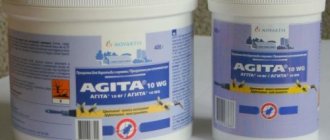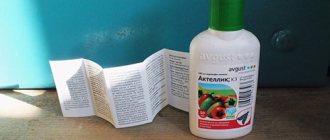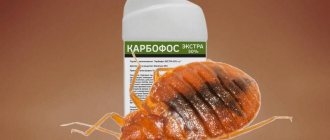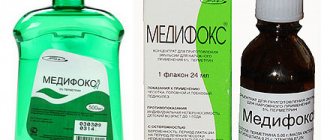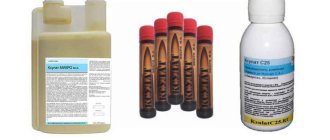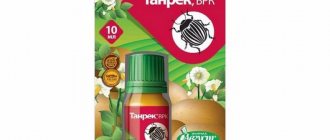Description and scope of application
Trichophyte (Trichodermin) is a biological product created by specialists as a preventive and antimicrobial agent aimed against common infections affecting the root system of plants.
This biological insecticide is universal, so it is used in various areas.
Photo of the drug Trichodermin
Currently, Trichophyte is used for the following purposes:
- To improve soil health. Often, pathogenic microorganisms that are dangerous to cultivated plants “hid” in the soil. The active substances that make up Trichodermin destroy infections and bacteria and saturate the soil with vitamins.
- For the prevention and treatment of house plants. Trichodermin is equally effective when used for spraying ordinary indoor flowers and for influencing rare decorative subspecies.
- For pre-sowing treatment of seed material (before planting seeds in a permanent place).
- For preventive treatment of garden crops.
The versatility of this biological product also lies in the fact that it is used in cosmetology, adding it to nourishing and restorative hair masks.
Fungus Trichoderma Lignorum
is part of Trichodermin, making this insecticidal biological product highly effective. This special ingredient inhibits the growth of pathogenic microorganisms that live in the soil. In other words, this product prevents the development of pathogenic bacteria that infect the soil and are the “culprits” of root rotting.
Tricophyte is also used as a disinfectant.
It effectively resists the following diseases:
- scab;
- fruit rot;
- fomoza;
- late blight;
- microsporiosis;
- powdery mildew;
- rhizoctonia;
- fusarium.
FERTILIZER!
Urea or carbamide Fertilizer Azophoska Ammophoska Fertilizer Nitrophoska
Action
External signs of some plant diseases that Trichodermin helps with
Trichodermin is a complex preparation of protection, stimulation of plant growth, fertilization and soil formation. Its active ingredients are produced primarily by germinating spores of the fungi Trichoderma sp. These are primarily antibiotics with a pronounced fungicidal effect: viridin, gliotoxin, satsukallin, trichodermin, etc. Therefore, Trichodermin is effective against more than 60 fungal and bacterial plant diseases, incl. such dangerous ones as (see also fig.):
- Alternaria
- Anthracnose
- Bacterial canker of fruit
- White and gray rot (fomoza)
- Clubroot cabbage
- Peach curl
- Powdery mildew (oidium)
- Fruit scab
- Rhizoctonioses
- Downy mildew (mildew, downy mildew)
- Late blight of potatoes and tomatoes
- Fusarium
- Black leg of seedlings and other root rots
By releasing antibiotics, beneficial mushrooms suppress natural competitors - harmful antagonist fungi and pathogenic bacteria. Next comes the fact that Trichoderma has long and firmly made friends with higher plants: the latter supply the soil with organic residues (withered grass, fallen leaves), and Trichoderma prepare a nutritious substrate from them for themselves and their partners. In nature, sprouted fungal spores begin to secrete enzymes that first promote ammoniation of organic amide nitrogen, i.e. cause non-pathogenic decay of organic residues. At the same time, their main nutrients (primarily phosphorus) and meso- and microelements (calcium, etc.) are released into forms digestible by plants. Next, the growing hyphae of the fungus secrete enzymes that nitrify ammonium nitrogen, i.e. converting it into a form accessible to plants.
The nutrient medium is not everything - the soil must be structured for plants to grow well. The primary formation of soil structure is carried out by plant roots; in close proximity to them, favorable conditions are created for the development of beneficial soil microflora and microfauna. An environment saturated with their organic secretions attracts earthworms and other soil-forming macroorganisms.
Trichoderma is involved in soil formation at all stages by secreting plant growth stimulants, mainly. root system. The lifespan of the thin “hairy” feeding roots of plants is short. They die, leaving breathable micro-holes in which soil microfauna and microflora develop especially successfully. Thus, the action of Trichoderma is clearly linked to the life cycle of partner plants: they are first provided with nutrition for germination and the formation of strong roots, then for the vegetative parts, and, synchronously with plant growth, its stimulants for both.
Trichodermin: composition and active ingredient
Initially, this drug was produced only in powder form, but then a liquid form of Trichoderma was also produced, which simplified the procedure for its use. In the manufacturing process of this product, saprophytic fungi are used, which, when multiplying, almost instantly suppress pathogenic microflora.
The product contains the following components:
- trichoderma fungus (spores and mycelium), which is produced in powder form and in the form of a suspension - this is the active ingredient;
- processed soil based on brown peat and fungal enzymes.
Photo of trichoderma fungus
How does the biological product work?
After treating the area with Trichodermin, the following occurs:
- The fungus that is part of the product begins to actively multiply. During its life, it releases a number of antibiotics, biologically active compounds and enzymes.
- The resulting substances have a detrimental effect on the reproduction processes of harmful microorganisms that are found in the soil.
- The drug continues to release carbon, with which it breaks down organic substances into inorganic ones. They are converted into mobile compounds of elements such as potassium, nitrogen and phosphate.
- As a result of splitting, the soil is enriched with useful minerals.
- The process of rotting and nitrification begins.
- Next, cell sap is formed, which increases the plant’s immunity and accelerates its growth and development. As a result of this action, the seedling becomes resistant to diseases.
The use of Trichodermin triggers the above processes. After a short period of time, positive changes become noticeable in the beds where vegetables, berry bushes and other plants that need fertilizer grow.
- 1
Fertilizers for petunia - 2
Yellow leaves on tomatoes - 3
Remedy against aphid - 4
Grapes Fungicides
Forms of release of the drug
Trichodermin goes on sale in two forms:
- dry powder;
- aqueous suspension (liquid).
1 g and 1 ml of these forms contain about 9 billion live fungal spores.
Important!
The powdered drug can be stored unpacked for up to 3 years, while the liquid form is more convenient to use.
To prepare a solution from powdered Trichodermin, proceed as follows: 1 g of powder is dissolved in half a glass of water, or a package (10 g) is dissolved in 1 liter of water. Pour the powder into warm water with constant stirring and leave in a warm, dark room for a couple of hours. The room temperature should not be lower than 15 C.
How to use Trichodermin for different crops
When feeding various vegetable and fruit crops, it is necessary to dilute Trichodermin in different ways.
For soil
To improve the composition of the soil and its quality, you need to dilute this product in the following proportion: 100 ml of the drug in 10 liters of water. For 1 kg of soil, 1 mg of Trichodermin is required.
Trichodermin for soil - video
[media=
https://youtu.be/fLR7qxEPvE8
]
For vegetables
This biological product is used for processing and feeding vegetables in the following cases:
- cucumbers are treated with Trichophyte against the following diseases - anthracnose, ascochitiosis, various types of rot;
- when tomatoes are affected by diseases such as root rot, late blight, macrosporiosis;
- if the cabbage is attacked by fomoz or black leg;
- for watering vegetable plants, the drug is diluted in the following proportions: 100 ml of Trichophyte per 10 liters of water;
- as a preventative against possible diseases, when seedlings develop at least a couple of true leaves;
- freshly prepared Trichodermin mixture can be used to treat vegetable crops no more than once every 14-15 days;
- Vegetable crops should be sprayed on cloudy days at sunrise or after rain. The ambient temperature must be at least 17-19 degrees Celsius;
- If the plants are severely damaged, you can treat them once every two days.
Trichoderma veride instructions for use
The doses of the drug "Trichoderma veride" for each culture are prescribed in the instructions for use. You need to prepare the solution only before starting treatment. To do this, dilute the specified amount of the drug in a certain amount of water, always stirring, add so much water so that you end up with 10 liters of solution.
Important! The method of seed treatment is selected depending on the disease that needs to be combated.
Processing of seeds and planting material
When, at what stage, to use Trichoderma veride, everyone decides individually, but experienced gardeners recommend starting to influence future plants with the drug when they are still at the seed or seedling stage. For this:
- On the eve of planting, place the seeds in a solution of the product (2%) for 5 minutes.
- Before planting in open ground, seedlings are dipped with their roots in a mixture consisting of soil and humus (2:1), 5 g of the drug and 5 liters of water.
- Before starting sowing activities, apply the solution or powder of the medicine directly into the holes or furrows.
Important! It is forbidden to make a solution of the drug based on chlorinated water.
Spraying plants
Plants are sprayed with a solution containing Trichoderma veride as soon as two true leaves appear, and Trichoderma, according to the manufacturer, will prevent the development of phytopathogens. Repeat the procedure every 14-21 days.
Plants should be treated in the morning or after sunset, the weather should be dry and windless. The best option is when the rain has already passed, but it is still cloudy, and the temperature is 18 degrees or higher.
The frequency of treatment may vary depending on the severity of the disease and reach 4-5 times every 7 days.
Watering with Trichoderma veride
You can add Trichoderma veride for watering each garden crop at the rate of 100 ml per 10-15 l or 30 g per the same amount of water. Proper use of the drug leads to an increase in yield by 20-30%.
Disinfection of seeds and seedlings
To completely disinfect seed material and seedlings grown at home, the following steps are carried out:
- one day before sowing the seeds in the ground, they are soaked in a Trichodermin solution (5 minutes, then be sure to dry before sowing);
- to prevent damage to vegetable crops and their fruits by root rot, the suspension consumption rate for each kilogram of materials is 35 g;
- to treat vegetable seedlings, it is necessary to prepare a solution in the following ratio: for every liter of water, 1 g of the drug;
- When planting seedlings or seed material directly on the beds, you can pour a 2% Trichophyte solution into each planting hole (no more than 4 ml of solution for each plant). You can also simply add a powdered preparation to each hole. The average dose for each square is 27 g.
Important!
When diluting powdered Trichodermin, you should not use water that contains chlorine.
Trichodermin or Fitosporin - which is better?
Fitosporin contains a spore culture, which in the process of life displaces and suppresses the emergence and further reproduction of most pathogenic bacteria and fungi.
Features of the use of trichodermin and phytosporin - video
The difference in the action of these two biological products lies in the speed of their effect on pathogenic microorganisms. Trichophyte begins to fight bacteria faster due to its unique composition. And Fitosporin has a slower spread, but has the ability to penetrate the stems and foliage of vegetable crops, resulting in the destruction of pathogenic microorganisms inside the plants. This drug is also used to treat fruits and plant tubers during storage.
Comparison with analogues
The following biological products can be identified as analogues of Trichodermin.
"Fitosporin"
It contains a spore culture that suppresses the emergence and reproduction of many pathogenic fungi and bacteria.
When choosing what is better to use - Trichodermin or Fitosporin, it is important to know that each biological product has its own advantages. "Trichodermin" begins to act more quickly on pathogenic organisms. “Fitosporin” spreads more slowly, but is capable of destroying harmful bacteria inside the stems and foliage of plants.
"Phytodoctor"
The basis of the drug is an improved Bacillus subtilis, which is destructive for a huge number of pathogenic fungi. The principle of action of the drug is similar to Trichodermin. Its main advantage is non-toxicity.
"Gaupsin"
The product is based on a pseudomonas preparation of two cultures of bacteria. It has entomopathogenic and antimicrobial properties. Protects plants from diseases and pests, heals the soil, promotes growth. It also increases drought resistance and water-holding capacity of plants. The drug is available in the form of a suspension.
"Riverm"
When using Riverma, there is no need to use other fertilizers, microelements and plant growth stimulants. Within 20 minutes after treatment, the solution penetrates deep into the cells and root system of the crops.
"Planriz"
The biological product contains soil bacteria. A plant protection product against leaf rust, root rot, powdery mildew and other diseases. Is a powerful growth stimulator.
"Trichopol" is sometimes classified as an analogue of "Trichodermin", but this is not the same thing. The basis of “Trichodermin” is natural bioactive microorganisms, and “Trichopol” is a synthetic antibacterial agent, the main component of which is metronidazole.
Precautions and storage conditions
Despite the fact that this biological product Trichodermin is safe for human health, when processing plants and fruit and berry crops, you should wear protective equipment - put rubber gloves on your hands, protect your nose and mouth with a respirator or gauze mask, and hide your body under thick clothing. After the plant treatment procedure, gloves and face protection are thrown away, clothes are washed and washed thoroughly with soap.
Growing Trichoderma - video
Trichodermin in the form of a suspension can be stored for no more than 3 years, and the powder form can be stored for up to 5 years. Store medications in a cool place. The diluted powdered fungicide can be stored for no more than 2 months at a temperature of no more than 5 degrees Celsius.
This biological remedy is a good alternative to chemical drugs, but only at the initial stage of illness. If crop plants are severely damaged, then the effectiveness of Trichodermin is reduced, so it is necessary to use chemical fungicides.
Compatibility of Trichodermin with other drugs
Trichodermin is well compatible with most other drugs that are used to care for indoor and garden crops.
Is it possible to combine different means of protection? - video
It can also be used in combination with other biological agents (with the exception of Mikosan). The effectiveness of Trichophyte increases with the combined use of drugs such as Fitodoctor and Fitosporin.
Important!
Trichodermin should not be used together with chemical fungicides and insecticides - such products neutralize the effect of Trichodermin on plants.
Reader Questions
How to use Trichodermin for cucumbers and tomatoes and what are the processing times?
The first time you should treat tomato and cucumber seeds with Trichodermin, soak them in the preparation for several minutes, then dry them well.
You can soak the roots of vegetable seedlings before planting in a greenhouse or open ground (1-2 hours) in a solution prepared as follows: 5 g of Trichodermin per 1 liter of water.
You should also spray during the growing season of cucumbers, tomatoes, and potatoes (consumption 1 liter per 20 m2). The spraying solution is prepared at the rate of 4-8 g of biological product per 1 liter of water.
Is Trichodermin dangerous for humans and pets?
The drug is non-toxic, therefore it is considered absolutely safe for animals and humans, as well as for insects. But when carrying out treatment, it is recommended to always use protective equipment in the form of rubber gloves and avoid contact with exposed skin. If Trichodermin gets on the skin, wash off the product immediately.
Where can I buy Trichodermin biofungicide?
This product is sold in almost all garden stores and large supermarkets. The price of Trichodermin depends on the packaging and packing - from 20 rubles (Trichoderma veride) and up to several thousand for large containers.
Reviews about "Fitosporin" and "Trichodermin"
The information presented in the article does not provide a definitive answer as to which is better: Trichodermin or Fitosporin . Both drugs cope well with bacterial and fungal infections. Can be used during different periods of the growing season. They do not pose a threat to humans or animals.
If you take Trichodermin, customer reviews are only positive. Almost everyone who decides to use the drug notes the rapid emergence of seedlings and an increase in yield when cultivating the soil. At the initial stages of fungal and bacterial diseases, the product copes well with them.
Reviews about the drug "Fitosporin" are also excellent. All gardeners and flower growers are satisfied with the result. Not only do vegetable crops feel good after treatment, but also indoor plants get rid of diseases, accelerate growth and delight their owners with lush flowering.
Both drugs can be used even on the day of harvest; this will not affect human health in any way. For both one product and the second, there is a small recommendation for use in the evening or in cloudy weather. How can you give preference to one of them after this? Gardeners will have to decide for themselves which product is more convenient for them to use and in what form.
The drug Trichodermin - reviews of use
Natalya, 40 years old:
“My indoor flowers began to wither and wither. I decided to replant them and saw that the root system was affected by root rot. To combat it, I used Trichodermin, a solution of which I washed the roots and leaves of the flowers. As a result, I saved almost all my indoor plants; only a few of the weakest ones died.”
Maria, 30 years old:
“Last year my vineyard began to wither, the foliage withered, the ovaries began to fall off. I sprayed it with everything, and as a result, only Trichodermin turned out to be effective. I treated the grapevines with a liquid solution of this drug three times, as a result I even partially saved the harvest. And the next year the grape bushes bloomed as before, and I now use Trichodermin as a prophylactic agent for processing grapes.”
Larisa, 30 years old:
“This year, all the seedlings planted in the garden beds were sick for a long time and began to fade. But I was recommended to water wilted seedlings with Trichodermin. As a result, the seedlings came to life, quickly grew and became stronger.”
Yulia, 45 years old:
“It has already become a tradition for me to soak the seeds before planting in Trichodermina; I have been carrying out this simple procedure for the last few years. And in my opinion, the product works because... the plants began to get sick less. You can buy Trichodermin in any store - it is a very affordable and effective remedy.”
The biological fungicide Trichodermin is recommended for use both in the garden and in the garden, it actively fights fungi and other infections, improves the composition and fertility of the soil and has a number of other advantages.
Therefore, you should have it in your garden “first aid kit” as a preventive measure and an effective fungicide.
